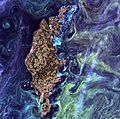Algal bloom facts for kids
An algal bloom is when tiny water plants, called algae, grow very quickly and in huge numbers in a body of water. Think of it like a sudden population explosion for these microscopic plants! These blooms can happen in both fresh water (like lakes and rivers) and salt water (like oceans). Sometimes, there can be millions of algae cells in just one milliliter of water.
Algal blooms are often green, but they can also be yellow-brown or red, depending on the type of algae. Some blooms are actually caused by Cyanobacteria, which are a type of bacteria that act like algae. These are sometimes called "blue-green algae." Some algal blooms, like the ones that cause "red tides," can be poisonous and harmful to other living things.
Contents
Why Do Algal Blooms Happen?
Algal blooms often occur because of something called eutrophication. This happens when too many nutrients, especially phosphorus and nitrogen, get into a body of water. These extra nutrients act like super-food for the algae, making them grow much faster than usual.
How Do Algal Blooms Harm Water Life?
When algae grow out of control, it creates big problems for the ecosystem in the water. Here's how it harms other animals and plants:
- Blocking Sunlight: The thick layers of algae on the surface block sunlight from reaching the algae and other plants deeper in the water. Plants need sunlight to make their own food (photosynthesis).
- Oxygen Depletion: The algae that don't get sunlight die and start to rot. This rotting process uses up a lot of the dissolved oxygen in the water.
- Creating Dead Zones: When there isn't enough oxygen, fish and other water animals can't breathe. Other water plants also suffer. Eventually, many organisms in the water die. This can lead to a "dead zone," where almost no living things can survive.
What is Eutrophication?
Eutrophication is the process where a body of water becomes overly rich in nutrients. These nutrients often come from human activities, such as:
- Farm Runoff: Fertilizers used on farms contain nitrogen and phosphorus. Rain can wash these chemicals into rivers and lakes.
- Sewage: Untreated or partially treated sewage also contains high levels of nutrients.
- Industrial Waste: Some factories release waste water that is rich in nutrients.
When these extra nutrients enter the water, they fuel the rapid growth of algae, leading to blooms.
Images for kids
-
Taken from orbit in October 2011, the worst algae bloom that Lake Erie has experienced in decades. Record torrential spring rains washed fertilizer into the lake, promoting the growth of microcystin-producing cyanobacteria blooms.
-
Cyanobacteria activity turns Coatepeque Caldera lake into a Turquoise color
-
Satellite image of phytoplankton swirling around the Swedish island of Gotland in the Baltic Sea, in 2005
See also
 In Spanish: Proliferación de algas para niños
In Spanish: Proliferación de algas para niños








